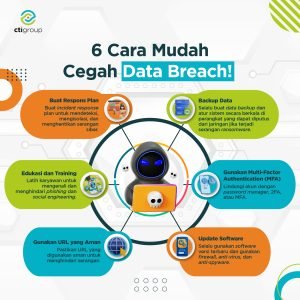Data breach is a serious threat to businesses in this digital age. In addition to financial losses, company reputation, and erosion of customer trust, data leaks now also have legal consequences and fines.
Data breach refers to a situation where valuable data is exposed or accessed by unauthorized parties. It should be reminded that data stolen by hackers is often used to launch social engineering-based attacks, such as phishing emails. Additionally, stolen user credentials can be sold on the dark web.
With the increasing complexity of cyber-attacks, businesses must take proactive steps to protect their data. This article will explore how to prevent data breaches, including understanding the causes of data leaks as a first step in protecting businesses from various cyber threats.
What is Data Breach?
A data breach is a security incident in which an unauthorized party gains access to sensitive or confidential information. This information can be personal, such as social security numbers, bank account numbers, and health records, or corporate, such as customer records, intellectual property, and financial information.
The term data breach is often used interchangeably with cyberattacks, but not all cyberattacks are data breaches. A data breach occurs when someone gains unauthorized access to data.
For example, a denial-of-service (DDoS) attack that takes down a website is not a data breach. On the other hand, a ransomware attack that locks up a company’s customer data and threatens to release it unless the company pays a ransom is a data breach. The physical theft of hard drives, USB flash drives, or even paper files containing sensitive information is also a data breach.
What is the Evolution and Impact of Data Breaches Today?
Data breaches must be taken seriously given the impact they have. According to the IBM Cost of a Data Breach 2023 report, the global average cost of remediating a data breach is $4.45 million, indicating that the problem is becoming more serious.
The consequences of data breaches tend to be more severe in highly regulated industries such as healthcare, finance and the public sector. In these sectors, heavy fines and penalties can add up. For example, the IBM report found that the average cost of remediating a data breach in the healthcare industry is $10.93 million, twice the average overall cost.
The IBM report also identified three main factors that lead to high data breach costs: lost business revenue, detection and response costs, and post-breach actions such as fines and legal settlement costs. In short, a data breach’s impact is not only financial, but also corporate reputation and customer trust.
What Causes Data Breaches?

Data breaches can occur due to various attack methods used by malicious actors. Some of the most common causes are as follows.
Malware
This malicious software can be unknowingly downloaded by users, giving hackers access to both infected and connected systems. Malware is often used to steal data for financial gain. There are several types of malwares, including viruses, keyloggers, Trojans, worms, rootkits, ransomware, and spyware.
Stolen Credentials
Stolen or compromised credentials are the second most common initial attack vector in data breach incidents. Hackers can steal credentials through brute force attacks, purchasing credentials on the dark web, or using social engineering tricks.
Social Engineering Attacks
This is the psychological manipulation of others to unknowingly compromise their own information security. The most common type of attack in this category is phishing, which uses emails, text messages, social media content, or fake websites to trick users into sharing credentials or downloading malware.
System Vulnerabilities
Hackers can gain access to a target’s network by exploiting vulnerabilities in websites, operating systems, endpoints, APIs, and common software used by service providers or enterprise vendors to steal data.
SQL Injection
This technique exploits SQL database vulnerabilities on insecure Web sites. Hackers insert malicious code into search bars and Windows logins to unlock personal information stored in the database.
Human Error and IT Failure
Human errors, such as misconfigured systems, can allow unauthorized parties to access data. Data can be exposed if it is stored in an insecure location, devices containing sensitive information are lost, or excessive network access privileges are granted.
Ransomware, a Malware Cause of Data Breaches
Ransomware, on the other hand, is a type of malware that encrypts user data and demands a ransom to unlock access to the data. Moreover, some ransomware variants steal sensitive information before encrypting it.
When ransomware steals data before encrypting it, it can lead to a data breach where personal or confidential information is accessed by unauthorized parties. Even if the ransomware perpetrator does not steal the data, the operational and financial impact of inaccessible data can be devastating.
In addition, businesses affected by ransomware are often forced to pay a ransom to get their data back. However, there is no guarantee that the perpetrator will provide full access after payment. In the worst-case scenario, the company could still be affected by a data breach even after paying the ransom.
How is Ransomware Evolving Today?
Ransomware is a type of malware that should not be underestimated. As mentioned above, ransomware attacks now include double-extortion and triple-extortion tactics, making the threat more serious even after data has been backed up or the initial ransom has been paid.
According to an IBM report, by 2023, 20 percent of global cyberattacks were ransomware. These attacks are also very fast-it takes hackers just four days to spread ransomware after infiltrating a network, leaving businesses little time to detect and prevent attacks.
In addition, the ransom demanded can be in the millions of dollars, but the total loss due to ransomware is greater. The average loss is $5.13 million, not including the ransom. In Indonesia, the National Data Center (PDN) also suffered a ransomware attack, resulting in the disruption of various government services and a ransom demand of about US$8 million, or about Rp131 billion.
What are the Stages of a Ransomware Attack?
A ransomware attack typically occurs in several stages:
- Initial Access: Attackers gain access through phishing, exploitation of vulnerabilities, or vulnerable remote access protocols such as RDP
- Post-Exploitation: Attackers use remote access (RAT) or other malware to solidify a position on the target system
- Understand and Extend: The attacker understands the local system and moves laterally to access other systems and domains
- Gather and Extract: Attackers identify and steal critical data such as login credentials and personal information
- Distribution and Delivery of Ransom Messages: Ransomware begins encrypting files, disabling recovery capabilities, and deleting backups, then sends a ransom message with payment instructions to obtain the decryption key
How to Prevent Data Breach and Ransomware?

After understanding the causes of data breaches and ransomware, it’s important for businesses to prevent them early on. There are six ways to accomplish this, including the following.
1. Back Up Data Regularly
Back up important data and systems regularly. Ideally, store it on a device that can be disconnected from the network during a ransomware attack, such as an external hard drive.
2. Use Multi-Factor Authentication (MFA)
Use password management, multi-factor authentication (MFA), single sign-on (SSO), and other identity access controls to secure accounts and credentials.
3. Update Software
Keep software, including firewalls, antivirus, and antispyware, up to date to close security gaps and protect organizations from data leaks.
4. Use Secure URLs
Make sure the website you are visiting uses a secure HTTPS connection.
5. Train Employees
Educate and train employees to recognize and avoid phishing attacks. Also teach proper data handling to prevent accidental data leaks.
6. Create Response Plan
Create an incident response plan to detect, isolate, and stop cyberattacks. Organizations with tested plans and dedicated teams can reduce the time it takes to respond to data breaches.
Also Read: 6 Tricks to Prevent Application Security Risks: Which Ones Have You Implemented?
Ensure the Security of Your Business with Trusted Data Protection Solutions from CTI Group
With the increasing volume and complexity of cyberattacks that can result in data breaches, it is important for businesses to have a thorough understanding of these risks. Businesses must take preventative measures by following the steps outlined above and deploying proven data protection solutions.
As a leading company with years of experience in the IT industry, CTI Group is ready to help protect and secure your business from cyber-attacks with a variety of proven data protection solutions. For more information, please contact us using the link below.
Author: Wilsa Azmalia Putri – Content Writer CTI Group

